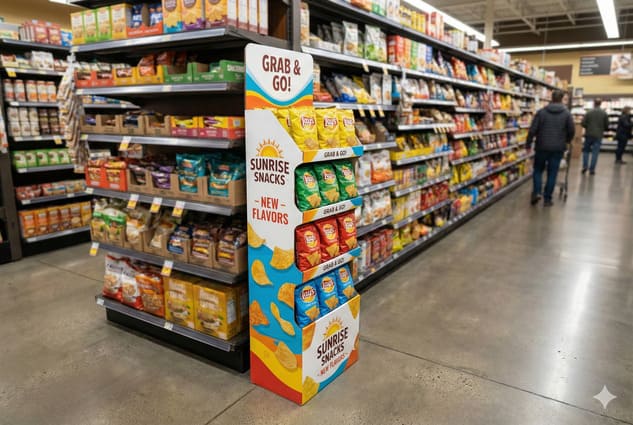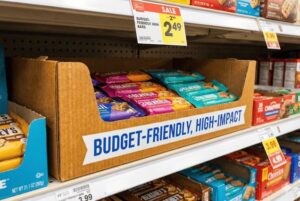Do you struggle to get your products noticed in a crowded retail store? You are not alone. Many brands fail to grab customer attention before they walk down the aisle.
A Free Standing Display Unit (FSDU) is a standalone retail fixture used to hold and showcase products. It is usually made from corrugated cardboard and placed in high-traffic areas like aisles to increase visibility. FSDUs are distinct from standard shelf space and allow brands to maximize impact during promotions.
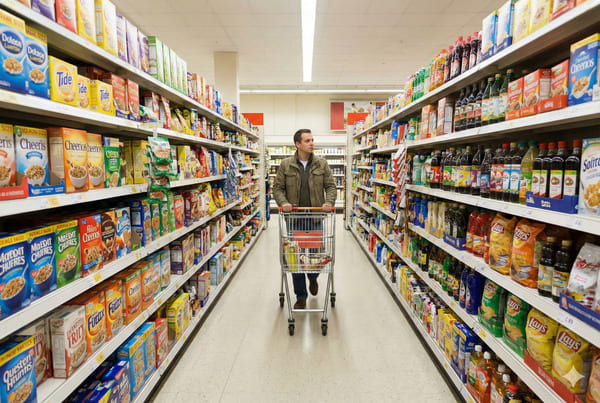
Let’s explore how these displays function and why they are essential for your retail strategy.
What is a free standing display?
Do you need a display that stands on its own without relying on store shelves? Relying only on fixed shelving limits where you can place your products.
A free standing display is a self-supporting structure used to showcase merchandise independent of store fixtures. These units allow flexible placement in open spaces, aisles, or near checkout counters. They are engineered to hold substantial inventory while offering large graphic areas for custom branding and promotional messaging.
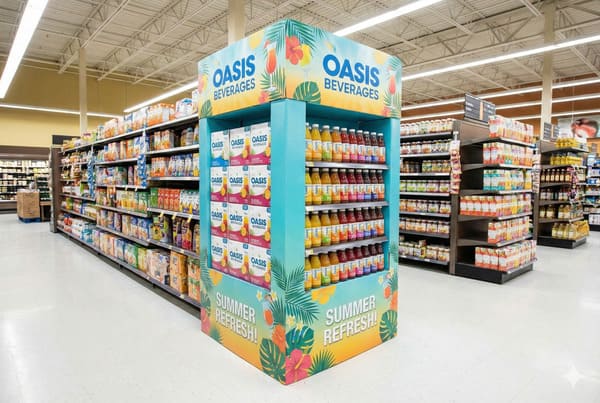
The Structural Advantage and Market Impact
I have spent years manufacturing displays, and I see that the biggest advantage of a free standing display1 is autonomy. You do not need to fight for limited shelf space. You create your own space. This is vital because Floor POP Displays2 account for a large share of the market, around 43.7% in some reports. They are effective because they interrupt the shopper’s path.
When we design these at my factory, we focus heavily on the material. Most clients prefer corrugated cardboard. It is cost-effective and strong. However, strength is a common pain point. I have seen displays collapse because the manufacturer used the wrong paper grade. At PopDisplay, we use load-bearing tests to ensure the structure holds your product safely.
Here is a simple breakdown of why you might choose a Free Standing Display3 over a standard shelf placement:
| Feature | Free Standing Display | Standard Shelf Placement4 |
|---|---|---|
| Visibility | 360-degree or multi-sided visibility | Limited to the front facing only |
| Location | Flexible (Aisles, End-caps, Entries) | Fixed to a specific aisle |
| Branding | Full body graphics and custom shapes | Small price tag or shelf strip only |
| Capacity | Can hold bulk stock or heavy items | Limited by shelf height and depth |
I often tell my clients that a free standing display is like a billboard that also holds product. It allows you to tell a story. For example, if you sell hunting gear, we can shape the cardboard to look like a tree or a cabin. This connects emotionally with the customer. This is something a standard metal shelf can never do.
What is a FSDU in retail?
Are you looking to boost sales volume during a specific retail campaign or season? Standard aisles often hide new product launches or seasonal items from potential buyers.
In retail, an FSDU is a strategic Point of Purchase (POP) tool used to drive impulse sales. Retailers use them to highlight seasonal products, new launches, or special discounts. They effectively disrupt the shopper journey, drawing attention to specific items outside the normal shelf environment to increase basket size.

The Role of FSDUs in Modern Retail Strategy
Retail is a battle for attention. An FSDU is your soldier on the front line. The "3-second rule" applies here. You have about three seconds to grab a shopper’s attention. An FSDU does this by using bold colors and unique shapes. This is why the Display Packaging5 market is expected to grow from about USD 24.7 Billion in 2025 to USD 41.7 Billion by 2035.
The demand is shifting towards sustainability. I work with many clients in the US and Canada who face strict environmental pressure. Retailers want displays that are 100% recyclable6. This is where cardboard shines. We now use high-strength recycled fibers that are just as tough as virgin paper.
Key Benefits for Retailers and Brands
• Impulse Buying7: Placing an FSDU near the checkout or in a main aisle triggers unplanned purchases. This is huge for FMCG brands like food, drinks, and cosmetics.
• Cost Efficiency8: Compared to permanent metal or wood fixtures, cardboard FSDUs are much cheaper. You can roll them out for a summer campaign and recycle them in the fall.
• Ease of Assembly: Retail staff are busy. If a display takes 30 minutes to build, they will throw it away. We design "flat-pack" units that pop open in minutes.
One challenge I help my clients solve is durability in the retail environment. A supermarket floor is wet and dirty. We apply eco-friendly coatings to the base of the FSDU. This prevents moisture from ruining the cardboard. This attention to detail ensures your brand looks premium from the first day to the last day of the promotion.
What is a PDQ display?
Do you need to get your product on the shelf quickly and look neat instantly? Unpacking individual items takes too much time for store staff and looks messy.
A PDQ display (Pretty Darn Quick) is a pre-loaded retail tray or bin designed for rapid setup. These small units are usually placed on counters, shelves, or pallet skirts. They maximize efficiency by allowing store employees to stock products instantly without arranging them individually, ensuring high planogram compliance.
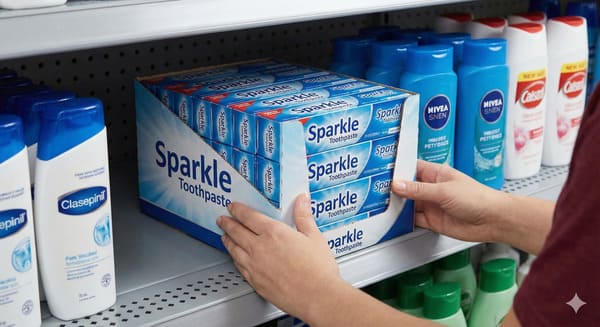
Speed and Efficiency in Big Box Stores
If you sell to big retailers like Walmart or Costco, you know they demand speed. They do not have time to organize your products. A PDQ display9 solves this. It comes with the product already inside. The store clerk just tears off the cover and places it on the shelf.
I have a client who sells small hunting accessories. Before using PDQs, his products were often lost or messy on the shelf. We designed a PDQ tray that keeps his products organized. This increased his sales because the product always looked ready to buy.
Here is how a PDQ differs from standard packaging:
| Aspect | PDQ Display10 | Standard Packaging |
|---|---|---|
| Setup Time | Seconds (Remove cover, place on shelf) | Minutes (Unpack, stack, organize) |
| Presentation | Branded, organized, professional | Relies on store staff to arrange neatly |
| Location | Counters, Shelf inserts, Pallet skirts | Standard shelf space only |
| Material | Corrugated cardboard (Lightweight) | varies (Cartons, plastic bags) |
PDQs are also great for impulse items at the cash register. Because they are small, they fit in tight spaces. We use digital printing11 for these smaller batches. This means you can have high-quality images on the tray without paying for expensive printing plates. It is a smart way to test new products without a huge investment.
What are freestanding displays?
Are you unsure which type of standalone display fits your product size and budget? One size rarely fits all when it comes to custom manufacturing and retail goals.
Freestanding displays are a broad category of standalone fixtures that include floor stands, pallet displays, and interactive kiosks. They come in various materials like cardboard, metal, or wood. Brands choose them based on product weight, campaign duration, and budget to create a dedicated brand zone.
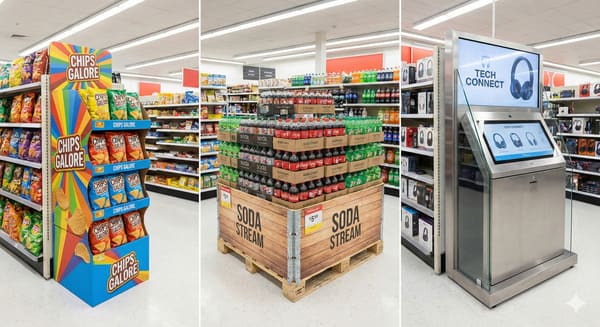
Customization and Future Trends
Freestanding displays are versatile. While I specialize in cardboard, the category includes many styles. You have Pallet Displays12 which are massive and ship directly on a wooden pallet. These are great for bulk items like soda or pet food. Then you have delicate Hook Displays for hanging items like socks or batteries.
The industry is moving fast. We are seeing a demand for "Smart Displays13." This involves adding QR codes or NFC tags to the cardboard. A customer scans the code and sees a video of your product. This connects the physical store with the digital world.
Choosing the Right Material
• Cardboard14: Best for short-term promotions (1-3 months). It is cheap, printable, and green. This is my expertise.
• Metal/Wood: Best for permanent fixtures (1+ years). They are expensive and hard to move.
• Plastic: Durable but less eco-friendly. Many brands are moving away from this due to consumer backlash.
I always advise my clients to consider the "lifecycle15" of the display. If you are launching a seasonal product, do not waste money on metal. Use a high-quality cardboard structure. It supports the weight, looks great, and costs a fraction of the price. Plus, with the rise of Gen Z consumers, having a recyclable display improves your brand image. We are also seeing a rise in "origami-style" structures that are incredibly strong but use less material, reducing shipping costs.
Conclusion
Freestanding displays are powerful tools to increase visibility and sales. They offer a cost-effective, sustainable, and customizable way to showcase your brand.
Would you like me to design a free 3D concept for your next product launch?
Explore the advantages of free standing displays to understand how they can enhance your marketing strategy and product visibility. ↩
Learn how Floor POP Displays can significantly boost retail sales by effectively capturing shopper attention and increasing product exposure. ↩
Explore this link to understand how Free Standing Displays can enhance visibility and branding in retail environments. ↩
Learn more about Standard Shelf Placement and its limitations in maximizing product exposure and customer engagement. ↩
Explore this link to understand how Display Packaging is evolving and its impact on retail strategies. ↩
Discover the significance of 100% recyclable packaging and how it meets consumer demand for sustainability. ↩
Understanding impulse buying can help retailers optimize their strategies and increase sales effectively. ↩
Exploring cost efficiency can reveal ways to maximize marketing budgets while maintaining effective displays. ↩
Explore this link to understand how PDQ displays can enhance product visibility and sales in retail environments. ↩
Explore how PDQ Displays can enhance product visibility and sales in retail environments. ↩
Learn about the advantages of digital printing for high-quality, cost-effective packaging solutions. ↩
Discover the advantages of Pallet Displays for bulk items and how they can optimize your retail space. ↩
Explore this link to understand how Smart Displays can enhance customer engagement and bridge the gap between physical and digital shopping. ↩
Explore the advantages of cardboard displays, including cost-effectiveness and eco-friendliness, to enhance your marketing strategy. ↩
Understanding the lifecycle of displays can help you make informed choices that align with your brand’s sustainability goals. ↩

